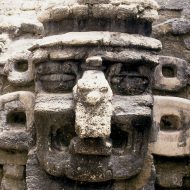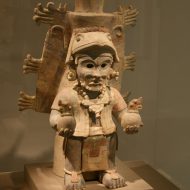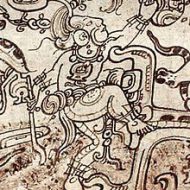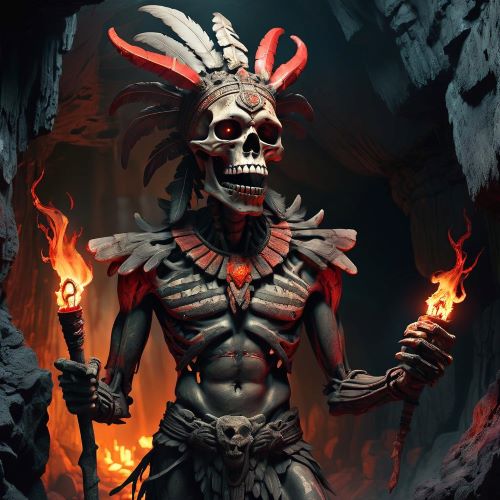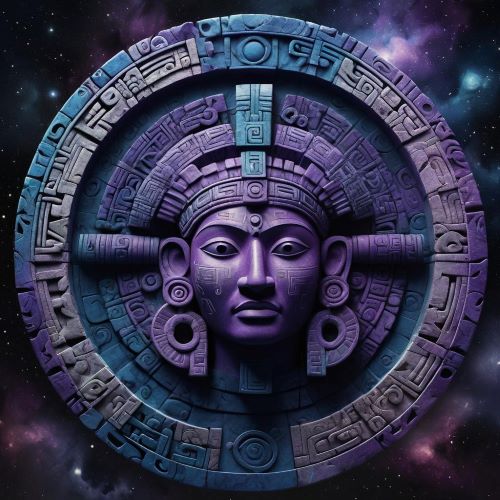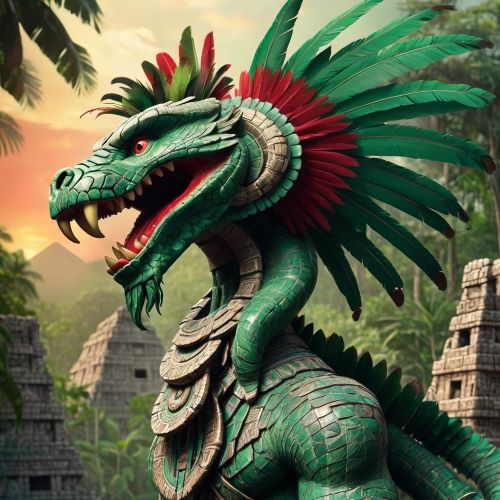Chaac : The Rain God
Listen
At a glance
| Description | |
|---|---|
| Origin | Mayan Mythology |
| Classification | Gods |
| Family Members | Sun God (Brother) |
| Region | Guatemala, Belize, Honduras |
| Associated With | Rain |
Chaac
Introduction
Chaac is one of the most important deities in Mayan mythology, revered as the god of rain, thunder, lightning, and agricultural fertility. His worship was especially strong in the Yucatán Peninsula of Mexico, where survival depended on seasonal rains to nourish maize and sustain daily life. Without Chaac’s blessings, drought and famine were constant threats, making him a central figure in the spiritual and agricultural practices of the Maya.
In Classic Maya art, Chaac is easily recognized by his round eyes, long hooked nose, and sharp fangs. He is not just a single god but exists as a group of four deities known as the Chacs, each associated with a cardinal direction and a symbolic color: red for the east, white for the north, black for the west, and yellow for the south. This division highlights the Maya’s cyclical worldview, where nature and the cosmos were ordered by balance and repetition.
During the Post-Classic period, Chaac’s worship involved complex ceremonies, including offerings and, at times, human sacrifices performed in sacred cenotes (sinkholes). At Chichén Itzá, priests known as chaacs held victims during rituals to appeal for rain, while statues called Chac Mool became enduring symbols of these ceremonies. These practices show how deeply intertwined Chaac was with both life and death, symbolizing nature’s dual ability to give and take away.
Physical Traits
Chaac’s appearance reflects his powerful and elemental nature. He is often portrayed as a hybrid being, combining human traits with amphibian or reptilian features that link him to water and storms. His most distinctive feature is his elongated, proboscis-like nose, sometimes compared to an elephant’s trunk, which emphasizes his control over rain and storm clouds. Large round eyes give him a supernatural presence, while his fanged mouth suggests the destructive power of lightning and thunder.
He frequently carries a jade axe or writhing serpents, both of which he uses as weapons to strike the clouds and release rain. In some depictions, snakes themselves become bolts of lightning, a vivid expression of his storm-bringing might. Shell ornaments, often shown hanging from his ears, symbolize his connection to water and aquatic life.
Chaac’s image dominates the architecture of Maya cities. At Uxmal, rows of Chaac masks decorate temple facades, with their protruding noses jutting outward in dramatic fashion. Similarly, at Chichén Itzá, his likeness adorns the Temple of the Warriors, further proof of his prominence in Maya religious architecture. These carvings served both decorative and spiritual functions, ensuring his presence watched over the people and their crops.
Family
In mythology, Chaac is often linked to other celestial beings, most notably in the Maya myth of the Sun and Moon. In this tale, Chaac and the Sun were raised by an adoptive mother, whom they later killed along with her lover. However, Chaac’s story takes a darker turn when he has an affair with the Sun’s wife. His tears of guilt and sorrow fell to the earth as rain, blending themes of divine passion, punishment, and renewal.
Some traditions also associate Chaac with the goddess Ixchel, the Mayan goddess of the moon, fertility, and medicine. This pairing symbolizes a balance between storm and regeneration, masculine and feminine energies, and the union of sky and earth. Together, they embody the life cycle of water—storms that nourish the soil and fertility that ensures crops grow.
By tying him to family dynamics and emotional struggles, the myths portray Chaac not only as a powerful elemental force but also as a being with human-like vulnerabilities and desires.
Powers and Abilities
Chaac’s powers revolve around rain, storms, and agricultural fertility, but his role extended beyond simply bringing water. His lightning axe allowed him to split open the heavens, releasing rain that sustained crops, rivers, and human life. He was also one of the deities who helped crack open the mythical mountain that held maize, releasing the sacred grain that became the foundation of Maya civilization. This act connects him directly to the most important food source of the Maya and underscores his role as a sustainer of life.
Rituals to honor Chaac were elaborate and essential to community well-being. In the Yucatán, a ceremony called the Cha-Chaac rainmaking ritual is still practiced today in some rural Maya communities. During this ritual, children gather flowers while elders chant prayers, and offerings of food are made to call down rain. In ancient times, ceremonies sometimes included casting people into cenotes as offerings. Those who survived and were pulled back were believed to have received visions or blessings from Chaac himself.
Chaac was not a solitary god. As the collective Chacs, he embodied the full cycle of weather patterns, with each color-coded direction ensuring harmony and balance. This division shows how the Maya viewed weather and agriculture not as random but as part of an ordered cosmic design.
Modern Day Influence
Though centuries have passed since the height of the Maya civilization, Chaac’s influence is far from forgotten. Archaeologists and historians continue to study Chaac’s imagery in temples, carvings, and codices, shedding light on his significance in Maya religion. His presence in rows of stone masks at Uxmal and in offerings found in the sacred cenote at Chichén Itzá makes him one of the most archaeologically visible gods of the Maya pantheon.
Chaac’s legacy also lives on in modern culture. He appears as a playable character in the online game Smite, where he is depicted as a warrior wielding his iconic axe. In Final Fantasy X, monsters inspired by him highlight his ongoing role in global storytelling. Beyond entertainment, Chaac continues to inspire indigenous rituals. Farmers in parts of the Yucatán still perform ceremonies to petition for rain, keeping alive the centuries-old tradition of calling on Chaac for sustenance.
Chaac endures as both a cultural and spiritual figure—an ancient rain god whose storms continue to echo in myth, ritual, and modern imagination.
Related Images
Sources
Encyclopaedia Britannica. (n.d.). Chac, Mayan god of rain. Retrieved from https://www.britannica.com/topic/Chac-Mayan-god-of-rain-especially-important-in-the-Yucatan-region
Wikipedia contributors. (2025, August). Chaac. In Wikipedia. Retrieved September 10, 2025, from https://en.wikipedia.org/wiki/Chaac
Maestri, N. (2018, July 28). Chaac, the Ancient Maya God of Rain, Lightning, and Storms. ThoughtCo. Retrieved from https://www.thoughtco.com/chaac-ancient-maya-god-of-rain-lightning-and-storms-171593
Wikipedia contributors. (2025, June). Ixchel. In Wikipedia. Retrieved September 10, 2025, from https://en.wikipedia.org/wiki/Ixchel
Sharer, R. J., & Traxler, L. P. (2006). The Ancient Maya (6th ed.). Stanford University Press.
Coe, M. D., & Houston, S. (2015). The Maya (9th ed.). Thames & Hudson.
Frequently Asked Questions
What is the meaning of Chaac?
Chaac is the Maya god of rain, lightning, and storms. His name means “axe” or “thunderbolt” in Mayan, referring to the lightning axe he wields. He was vital for agriculture and fertility.
What god is Chaac?
Chaac is the Mayan rain god, ruling over rain, thunder, lightning, and agriculture. He ensured crops would grow by bringing essential rainfall. He is often compared to other storm gods like Zeus or Indra.
Why is Chaac so important?
Chaac is important because the Maya relied on him for rain to grow maize and sustain life. Without his blessings, drought and famine threatened entire communities. He symbolized survival, fertility, and the connection between humans and nature.
Does Chaac have a wife?
Yes, Chaac’s wife is often identified as Ixchel, the Maya goddess of the moon, fertility, and medicine. In some traditions, she represents the balance to his rain-bringing powers.
How is Chaac usually depicted in Mayan art?
Chaac is often shown with a serpent-shaped nose, fangs, and carrying an axe, symbolizing lightning and storms. Sometimes he appears with water imagery to emphasize his power over rain.
Watch
I am raw html block.
Click edit button to change this html


